German aircraft engine Jumo-213
General guidance for the development of the Jumo-213 engine was provided by Dr. Lichte. Dr. Lichte supervised the development of the engine, and bringing it to the required level of reliability, as well as the organization of mass production after receiving the first version “A” that was ready for mass production. The work supervisor, Dr. Lichte, said: “Initially, Jumo-213 was designed to achieve maximum mechanical and thermal loads and was the highest stage in the development of four-stroke internal combustion engines that worked on the Otto cycle.” This statement describes the engine as a very serious achievement in the field of aviation engine building. The first pre-production version of the engine in the middle of the year 1942 developed the power of the 3250 hp at 1750 rpm. (1285 kW). This figure on 30% exceeded the power of the serially produced Jumo-211F engine, produced at that time. At the same time, in comparison with the Jumo-211F, the new engine had a lower specific fuel consumption. On the earlier tests of the engine Jumo-213 no documents have been preserved.
The first ideas of developing an aircraft engine with a capacity of 35 liters with increased power appeared in the autumn of 1936 - in the winter of 1937, after the start of testing the Jumo-211 engine. Begin testing Jumo-213 planned spring of the year 1938, after the design, refinement and assembly of the first prototypes. The RLM document from 21 June 1939 of the year states that tests of the Jumo-213 prototype engines began in August of the 1938 year. Another document from 04 in November 1939 of the year, compiled on the basis of a meeting of representatives of Jumo and RLM, reported that during testing of this engine on test benches (conducted during the year) Jumo-213 managed to develop power in 1500 hp This figure does not exceed the power of prototypes Jumo-211, however, as already mentioned, the fuel consumption was lower than that of its predecessor, although slightly lower than expected. In this regard, it was necessary to refine the system of gas exchange process and fuel injection.
From the above, it follows that the bench tests of the Jumo-213 engine passed with problems, and the elimination of the arisen problems took a lot of time, which during the war years was not enough. However, in January, 1940, despite the problems, for the flight tests of the Jumo-213, which has reduced power, prepared the Ju-52. Following the results of these tests, a detailed report on the engine was compiled. It was planned to release the 30 Jumo-213 zero series engines. Optimistic plans for the engine in practice so quickly failed to realize, because during the bench tests there were all new problems, the elimination of which took time. As mentioned above, in principle, Jumo-213 was not much different from its predecessor, Jumo-211. This mainly concerned the engine block and the location of the cylinders. In accordance with the requirements of increasing power and the experience gained during the work, the prototype received some improvements in terms of design and operation. New developments and major changes used in the Jumo-213 engine were:
Water cooled cylinder heads; adjustment of the gas distribution mechanism; on each cylinder 1 exhaust and 2 intake valves; injection of special mixtures that provide additional cooling of the cylinders and heat removal from them.
Camshafts new type, which relied on 7 indigenous journals; counterweights on both ends of the camshaft; ball bearings; an additional shaft for selection of power to the fuel pump.
Crankshaft new type, having 7 indigenous necks and one additional front for a pulley that meets the requirements of achieving maximum speed; power take-off to drive mechanisms in the rear of the crankshaft; counterweights; Front - reducing gear screw.
An adjustable pitch propeller having a pressure lubrication system through a hollow shaft; In the front of the engine block there are special bearings that perceive axial and radial loads and the rear pulley.
The use of high-rise DVL superchargers in one-stage and two-stage versions with two and three speeds, as well as an adjustable position of the blades at the entrance to the supercharger; Increase in charge air pressure by 50% at different altitudes (up to 10 km).
The fuel injection system, made in the form of a dual pump that supplies fuel from the tanks; high pressure fuel pump; spiral air filter; fuel metering sensor; the use of high pressure fuel pump nozzles; the possibility of using conventional aviation gasoline B4 (octane number 87) or special deficit for Germany С2 (obtained by distillation of oil) and synthetic С3 with octane number 95-100.
Dual-circuit cooling system under pressure (maximum operating temperature of the coolant 120 ° C).
Pressure lubrication system using several gear pumps that supply and collect engine oil; centrifugal oil filter; main and additional oil flows; oil radiator; heat exchange with a cooling system.
"Commandoget" - mechanical "computer", which regulates some of the parameters of the power plant; the fuel supply was regulated by the pilot; engine revolutions, supercharger speed, boost pressure, ignition of the air-fuel mixture in the cylinders, screw installation angle were adjusted automatically.
During the war, an increase in the power of the power plant was achieved by increasing the maximum engine speed, increasing its working volume, increasing the boost pressure, and also due to improved internal or external cooling. To improve internal cooling, the MW-50 system was used.
All these innovations were based on the high parameters of various engine processes and made it possible to obtain high performance of the Jumo-213 engine. Thus, closer to the end of World War II, another piston aircraft engine, quite perfect for its time, was received. However, before it was possible to bring it, it took some time, and the date of commencement of mass production was postponed several times to a later date. The director of engine manufacturing, Jumo Cambeis, each time explained to RLM the reasons for postponing production. After the 7 successful 100 hourly tests of the JUMO and RLM engine in October, 1942 finally got the opportunity to begin mass production. To this end, under the direction of Dr. Lichte, a large Jumo-213 troupe was organized in Dessau, which has been engaged in similar tests around the clock for many weeks. However, during test flights of Fw-190 fighters equipped with Jumo-213, a powerful engine vibration appeared, transmitted to the aircraft body and not allowing the pilot to observe the instruments and use the onboard armament sight. The vibration was initially insignificant, but then, during the tests, when all the equipment was mounted in the engine compartment, the Jumo-213 vibration increased significantly. After extensive testing during numerous flights and some modifications in the summer of 1943, it was possible to reduce the vibration to a value that allowed the engine to be used on airplanes. To do this, made a new crankshaft. This again took time, and it was only in October 1943 that the mass production of the Jumo-213 engine could begin. Engine production was rather slow: until the end of 1942, the entire 74 engine was manufactured. During the 1943 year, monthly production was often engine 1-2. It was only in January that 1944 produced 100 engines. Already in March, the number of engines produced was more than 500 pcs.
The maximum production volume was reached in February 1945 of the year - 994 pcs. The engine was equipped with a special Motor Bediensgerät (MBG) developed by Junkers - a counterpart developed by BMW Kommandogerät, which greatly simplified the adjustment of engine operating parameters depending on its mode of operation and the height of the aircraft. The engine at start developed about 3250 revolutions per minute. During the climb and on combat mode, the speed was 3000 rpm. Economy Mode - 2100-2700 revolutions per minute. The maximum speed at take-off of a more advanced version of the aircraft engine - Jumo-213J - was 3700 revolutions per minute. Climbing and combat mode - 3400 revolutions per minute, economy mode - 3000 revolutions per minute. The long time spent on the development and organization of mass production (7 years!) Of the Jumo-213 engine and the catastrophic shortage of materials necessary for this did not allow for the production of this engine in significant volumes at the end of the war. In addition, it was not possible to refine the more advanced versions of the engine Jumo-213. The unfavorable developments for Germany increasingly demanded fighters equipped with powerful engines that were based on one version.
The main modifications and projects of the engine Jumo-213:
Jumo-213
Modification of the engine Jumo-213, intended for installation on bombers. In Jumo-213A there was no possibility of installing an automatic gun in the collapse of the cylinders. The pre-production batch of the Jumo-213 A modification was released in the 1942 year. In August, the 1944 of the year began large-scale production. Take-off power was 1750 horsepower (1285 kW), altitude 5500 m. Supercharger 2-speed single-stage. When the engine is equipped with the MW-50 system, the engine could develop the horsepower 2100. (1540 kW) for 10 minutes. After that, the engine must operate for at least five minutes in normal mode. If the MW-50 system is turned on, the boost pressure is increased by the 0,28 atmosphere. At an altitude of 5000 m, the power developed by the engine was equal to 1900 HP. (1395 kW). It was assumed that this modification will be installed on the bomber Ju-88 and Ju-188.
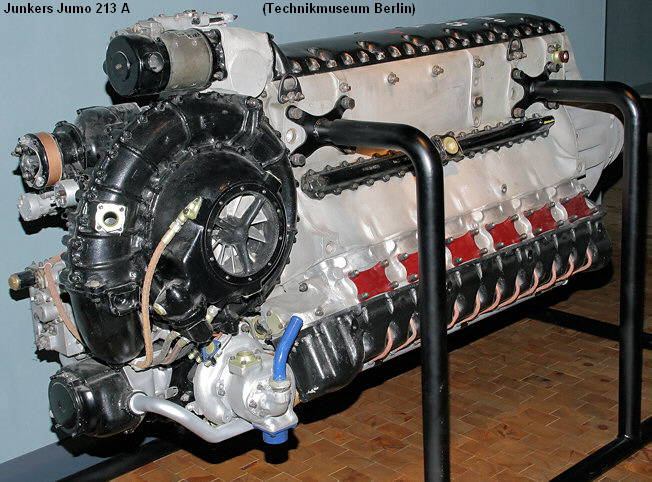
Jumo-213 AG
Variation of the engine Jumo-213A, equipped with a more productive supercharger. Takeoff power of the engine Jumo-213 AG - HP 1900 (1400 kW). This engine was installed on the FW-190 fighter series D-9. The MW-50 system allowed to increase engine power up to 2240 HP. on 10 minutes. At the same time, the altitude decreased to 4750 m with 5500 m. With the GM-1 system at the height of 10000 m, the FW-190 of the D-9 series developed a speed of 700 km / h. This allowed the aircraft to successfully destroy enemy high-altitude fighters. This speed exceeded the speed of the FW-190 D-11, equipped with a high-rise engine Jumo-213 F without the use of the GM-1 system. True, there was a significant drawback - 105 kg mix for GM-1, located on board, provided the entire 15-17 minutes of flight. Jumo-213AG for FW-190 D-9 fighter jets for assembly plants was supplied with a Junkers VS 111 propeller, an armored radiator, a motor frame, jet exhaust pipes, a coolant temperature regulator, a switchgear that was used to supply warm air for heating to the onboard armament, as well as sensors for measuring temperature and altitude. The variant for twin-engine aircraft had some differences from the engine planned for single-engine fighters. This option was performed as a “unified power plant” and was interchangeable with the power unit DB-603, which had several large dimensions, but approximately the same mass. The Jumo-213 AG engine was additionally equipped with a warm air intake system used to heat the wings and the pilot's cabin, as well as a 3000-watt generator.
Jumo-213 B
Special modification with a greater degree of compression. The take-off power of this engine was HP 2000. (1470 kW). Jumo-213 B was developed for gasoline having an octane rating of 95 units. The engine passed the bench tests, however, due to the acute shortage of high-octane aviation fuel, serial production of this engine was not established.
Jumo-213C
Variation of the engine Jumo-213A. Jumo-213С designed to equip fighters. There was the possibility of installing an automatic gun in the collapse of the cylinders. The system for adjusting the angle of the propeller blades changed. The engine had a flange to which an automatic gun was attached. Mass production began in September 1944.
Jumo-213
This modification was originally a Jumo-213А / C engine that worked on gasoline with an octane rating of 95. The height of this engine is 9800 m. A two-stage three-speed supercharger with a built-in charge air cooler. The Jumo-213EX1 version, which operated on B4 gasoline (87 octane number), developed the 1750 hp take-off power. (1285 kW). It was originally intended to start mass production of a more powerful version of the Jumo-213Е0 with the take-off power of the 1870 hp. (1375 kW.), Which used C3 gasoline (95 octane number). In the future, the developers expected an increase in take-off power to 2000 hp. (1470 kW). However, by the middle of 1943, the production of C3 gasoline did not fully meet the needs of the Luftwaffe, and therefore it was decided to develop and launch the mass production of Jumo-213Е1 with slightly less power. The E1 version required B4 gasoline (87 octane number), produced in large quantities. The MW-50 system, when used at altitudes below the calculated, increased the power of the Jumo-213 Е1 engine to 300 hp. The consumption of water-methanol mixture was 150 liters per hour. The duration of work in this mode was no more than 10 minutes, followed by a system shutdown for at least 5 minutes. At altitudes above the calculated use of the GM-1 system allowed to achieve a short-term increase in power on 400 hp. Depending on the mode, the mixture supplied by the GM-1 system could be consumed at speeds of 60, 100 or 150 grams per second.
Jumo-213EV
Jumo-213E engine variant with greater take-off power - HP 1900 (1400 kW). The increase in power was achieved by using a more efficient blower designed to provide high performance at low altitudes. Bench tests were conducted engine. At the beginning of 1945, preparations were made for serial production of the Jumo-213E modification. The altitude of this variant was 9000 m versus 9800 m in Jumo-213-1.
Jumo-213F
This modification was a Jumo-213E engine without intermediate charge air cooling. Its functions were performed by the injection system of a mixture consisting of water and methanol (MW-50). This ground level engine developed power up to the 2120 hp. (1560 kW). The altitude of the engine Jumo-213 F - 9500 m. This option was prepared for mass production in 1945 year. About ten engines of the pre-production lot were sent to Focke-Wulf aircraft assembly plants. They were used in the Fw-190 D-11 fighter jets that took part in the battles. A small number of Fw-190 D-11 fighters deployed to the troops did not have any serious impact on the enemy, although the machines had already managed to prove themselves well.
Jumo-213J
This modification is a significantly revised version of the high-rise engine. In this engine, the diameter of the cylinders was increased to 155 millimeters compared to 150 millimeters in the original version. Preserved piston stroke - 165 millimeters. Engine capacity increased to a liter 37,36. Also increased the maximum engine speed, which now accounted for 3700 revolutions per minute. Each new cylinder head received a valve 4 instead of 3. In addition, the engine was equipped with a more efficient supercharger and more advanced cooling system. By the end of the war, the engine was refined and very quickly began to be tested on the bench in the absence of the supercharger necessary for it, as well as a number of other units. It was not possible to carry out a full cycle of bench tests. Take-off power should have been 2250 HP. (1655 kW). The MW-50 system increased power to the HP 2600. (1910 kW). Extremely high engine performance parameters limited the motor life of the entire 40-50 for hours, which allowed using the Jumo-213J engine mainly on fighters. The altitude of this modification was 11000 m.
Jumo-213S
This engine was designed specifically for the Eastern Front, where the main air battles were conducted at altitudes below average. Take-off engine power was equal to 2400 hp Altitude - 4500 meters. Work on the Jumo-213S by the end of the war was close to completion, because it was fairly simple to execute.
Jumo-213T
This modification was a high-altitude engine equipped with a turbocharger (ATL). At ground level, the power of the Jumo-213T engine should have been equal to the power of options A, C, or E — the HPN 1750. (1285 kW). The calculated power at the height of 11400 m should have been equal to 1600 hp (1160 kW).
All of the above modifications of the Jumo-213 engine were developed in parallel in the last years and months of World War II. The lack of necessary materials and the ever-increasing bombing of the Allies significantly slowed down the progress of work. At the end of the war, not all projects were tested, however, a number of Jumo-213 series engines were manufactured and used. For example, a number of high-altitude modifications of the Jumo-213 engine (E and EB) were collected at the end of 1944 - the beginning of 1945's. About ten pre-production samples of modification F were transferred to the aircraft assembly facilities.
The main purpose of work on this type of engine was to get small power plants in size and weight. The transition from the production of Jumo-211 engines to Jumo-213, which was more advanced in all respects, was quite a challenge. Initially, the take-off power of various engine variants was close to the power of the first serial Jumo-213А, while the height increased, as well as the power developed at high altitudes. The last limited-edition version of the Jumo-XNUMHEV had a slightly increased take-off power. However, by 213, the engine power in the 1943 HP was not enough to confront the Western allies, who had at their disposal great resources and had already begun production in ever-increasing volumes of advanced piston aircraft engines whose power at a large altitude range was more than 2000-2000 hp
RLM in the conditions of extreme haste tried to find a way out of the current extremely difficult situation. Some previously abandoned projects and research have tried to reanimate. Attempts have been made to unite already disheveled or mass-produced engines, as well as to more intensively explore the field of turbojet engines.
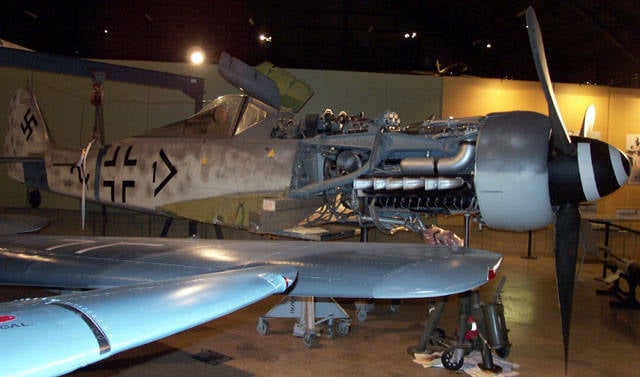
A significant increase in power in comparison with the previously developed modifications was supposed to be obtained on modifications Jumo-213J. This version of the Jumo-213 engine was a new type of aircraft engine with an altitude of 11000 m. The thorough changes in the design associated with this modification made it possible to get a larger working volume and increase the maximum speed. The development of a new supercharger from Jumo employees demanded that considerable effort be made and to use all the experience accumulated by that time in the development of piston aircraft engines. If the developers had the time necessary for the development of this modification, one would have expected from the Jumo-213J the appearance of the most advanced in a number of basic parameters of a piston aircraft engine. The difficult situation of the German industry and the extremely short time available to the engine developers did not allow them to organize the production of this engine in a timely manner, as well as to thoroughly test such engines necessary for the Luftwaffe. The first production versions of the Jumo-213 engines developed a maximum of 3250 revolutions per minute. This figure was very high, as was the associated average piston speed 17,9 m / s, which was maximum if we consider actual piston aircraft engines produced at that time. Jumo-213J with its 3700 rpm and average piston speed of 20,35 m / s exceeded these already high parameters.
The average piston speed of the most advanced aircraft engines in the world at that time rarely exceeded 15-16 m / s. Already at these rates, large dynamic and kinematic loads on the engine crankshaft began to be felt. Dynamic loads on connecting rods and pistons, valve accelerations and huge loads on bearings and main journals were almost 2 times higher than those of engines produced earlier. The resulting loads led to an increase in vibration and increased wear, which were above average for such aircraft engines. Without a doubt, this created many problems in design and production and led to a significant reduction in engine life during operation. Reducing the service life of the modification Jumo-213J, intended for fighters, to 40-50 hours in the situation in the second half of the war, when everything that was at the disposal of aircraft manufacturers was at stake, was justified. Such a reduction in engine life due to obtaining high power characteristics in civil aviation simply could not take place.
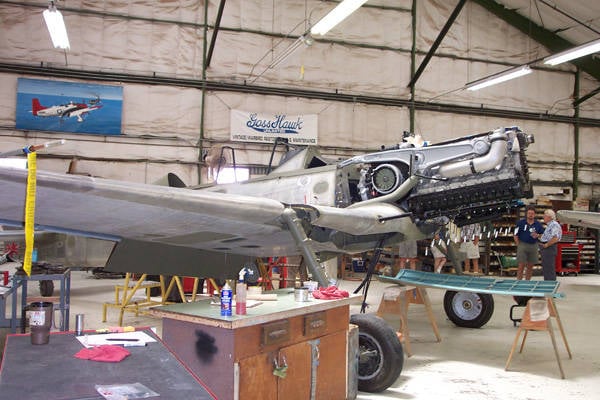
Any data on the course of bench tests of the engine Jumo-213J is not preserved. According to the company Jumo (rather poor), only 14 March 1945, 6 Jumo-213E engines were transferred to the appropriate branch of the company for modification to Jumo-213J. The first reworked model, designated Jumo-213JV1, was used again for bench tests. During the test, increased wear of the valve seals and valve seat seats was detected. More about the progress of further work on the Jumo-213J engine is not known. In this regard, for this engine to give a full assessment of the work is not possible.
The same can be said about the blower and the charge air cooling system, designed specifically for the Jumo-213J, and there are no data on the performance of the heat exchanger and the blower. The radial blowers that were used on aircraft engines also had certain difficulties associated with mechanical limitations caused by high angular velocity, reaching 400 m / s. This value was the limit, and it was impossible to exceed it. The new two-stage supercharger of the Jumo-213J engine, which had adjustable performance depending on the stage and should have greater performance than all previously used, had to be brought further (it would also take a lot of time), and it was impossible to get it as soon as possible. It is not possible to immediately obtain the high performance of the entire power plant. In addition, it was necessary to increase the 30% efficiency of the engine cooling system.
Previously obtained experience showed that cooling-recovery using the air-to-air principle already with Jumo-211 was not very effective. In this regard, the Jumo-213E engine used heat exchange not by air, but due to the cooling system of the engine itself.
Due to the greater efficiency, the cooling system according to the “air-liquid-recovery” principle could be smaller in size, have less pressure loss, and also did not create additional resistance to the oncoming air flow. In a more advanced sample of the Jumo-213F high-altitude engine, external cooling of the air supplied by the supercharger was replaced by a different principle of cooling the forced air. The principle of cooling was based on internal cooling due to the injection system of a mixture of water and methanol MW-50, in which the mixture of alcohol and water supplied to the engine cylinders contained 50% of these components. When the mixture evaporates in the engine cylinders, the engine cooled without leakage. The engine Jumo-213J presumably it was decided to use the same principle of cooling.
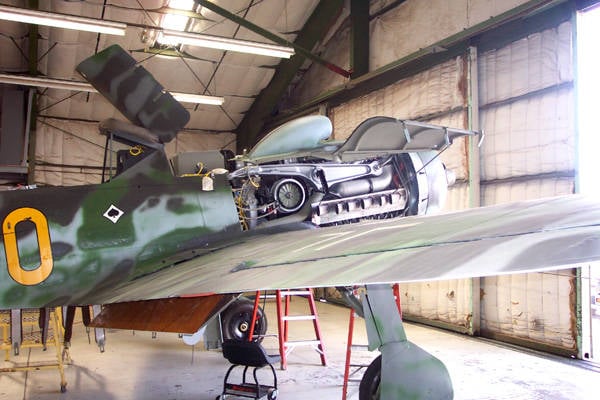
The development of new power plants of greater power was associated with the emergence of increasing problems. Moreover, a number of basic parameters could not be exceeded. This significantly increased the time to bring power plants to an acceptable level of reliability. At the same time, the Jumo-213 engine showed that the principles of operation of piston aircraft engines came very close to the limit, the excess of which became extremely dangerous. Achievement of the limiting values of some parameters had a negative impact on the time of bringing power plants, mastering their mass production, maintenance and repair.
Using the example of Jumo-213, it can be seen that the situation with the development of piston engines and the principle of their operation, regardless of the conditions associated with active hostilities, came to the limit beyond which further improvement of the characteristics of piston engines did not exist. was possible.
In 1943-1945, the Jumo-213 engine was often installed on a large number of German combat aircraft to improve their performance characteristics as a replacement for the Jumo-211 engine: Ta-152, Ta-154, Fw-190D, Ju-88G, Ju-188 , Ju-388, Me-309, He-111H, He-219. The insufficient number of Jumo-213 engines produced affected the production volumes of most of these aircraft: they were not particularly large. In the summer of 1943, when the Jumo-213 engine was already brought to the required level of reliability, all forces were thrown at the organization of their mass production in the largest possible quantity. The reason for this was the fact that the fighting in the skies of Germany were more and more acute. The use of Ta-152 and Fw-190D fighters equipped with Jumo-213 engines would have made it possible to counter some of the increasing qualitative and quantitative superiority of the Allied air forces over the Luftwaffe.
Jumo-213 engines gradually began to displace the BMW-190 air-cooled engines that were installed on the Fw-801 fighter jets, which had large dimensions and weight. The Jumo-213 engine at the Jumo engine-building enterprises in terms of serial production overshadowed the promising 24-cylinder multi-row Jumo-222 engines, which had even more power. The reasons for this were the long-running of the Jumo-222 engines (mid-1942 of the year), as well as the lack of free production capacity and equipment for organizing the mass production of Jumo-222 as soon as possible. For the manufacture of Jumo-213 engines it was possible to use some equipment and accessories used to manufacture the Jumo-211 engine.
As noted earlier, Jumo has made tremendous efforts to increase the production of Jumo-213. In the city of Magdeburg, an engineered line for the production of cylinder heads for Jumo-213 engines was installed at the engine-building enterprise. To process one cylinder, no more than 2 minutes were spent. At this installation, about 600 cylinder heads were processed during the day. Rationalization has also undergone the manufacture of other engine parts: valves, crankshaft and others. The test benches of Jumo, despite the reduction in the duration of engine testing, continued to work around the clock. According to the documents of the company Jumo, they produced the entire 9163 of the Jumo-213 engine of various modifications.
The insignificant production volumes of Jumo-213 were caused not only by the above reasons, but also by the need to pay attention to the development and organization of the mass production of the Jumo-004 jet engine. Work on this engine, so necessary for the Luftwaffe, was carried out at Dessau.
Modification E of the engine Jumo-213 was the pinnacle of the development of the German aviation engine. However, apart from the various variants of the Jumo-213, there were quite a few plans for the company Jumo, which were associated with attempts to develop a more powerful engine based on it. From negotiations between representatives of RLM and Jumo from 10 and 11 in November 1938, it follows that at that time there were plans to produce an experimental batch of Jumo-212 engines. Jumo-212 was a pair of Jumo-213 engines that were paired and united by a common reduction gearbox. This power plant was considered as one of the options for equipping a heavy bomber Non-177. Another new engine was the Jumo-214 engine, which later became the Jumo-213C. In the ruins of the cylinders of this engine could mount an automatic gun. Jumo-215 is a twinned Jumo-214 which, like the Jumo-212 engine, had a common gearbox on the 2 engine. The development of the Jumo-215 was started after the Jumo-212 engine successfully passed bench tests. After the end of World War II, work on the Jumo-212 continued in France. At the same time over Jumo-215 no longer worked.
Based on materials:
http://alternathistory.org.ua/aviatsionnyi-dvigatel-bolshoi-moshchnosti-jumo-213-germaniya
http://de.academic.ru
http://airspot.ru
http://bronay.ru
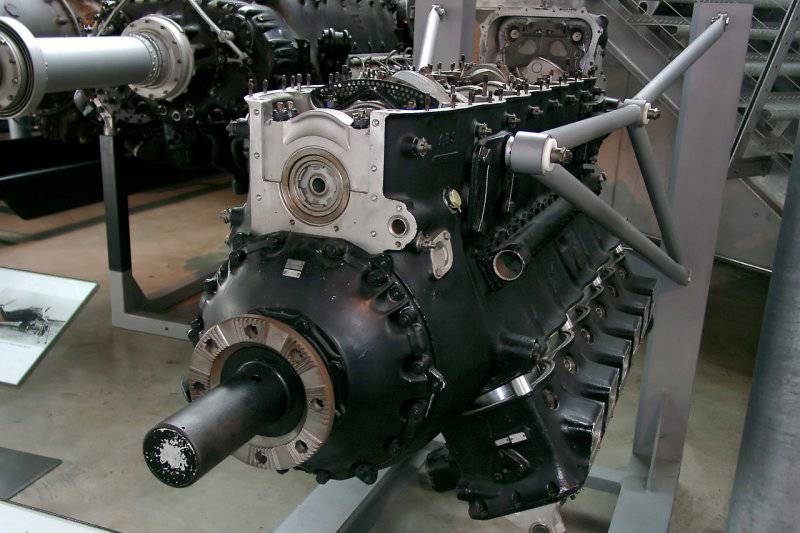
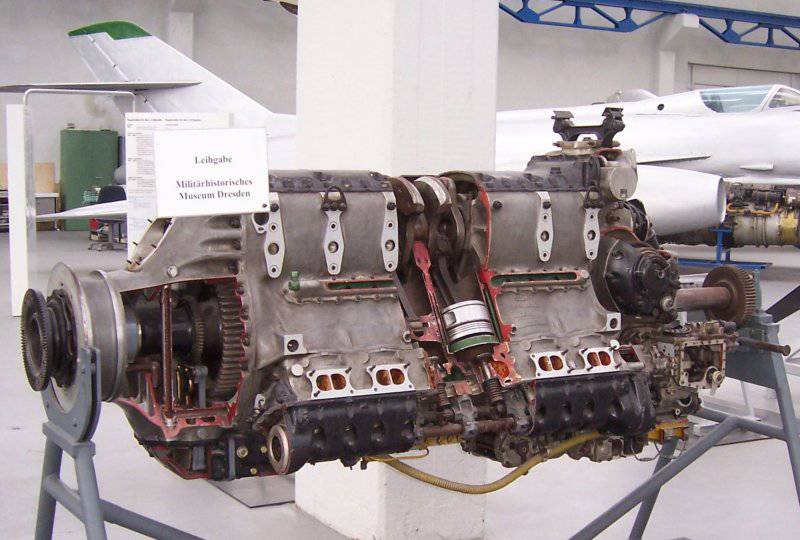
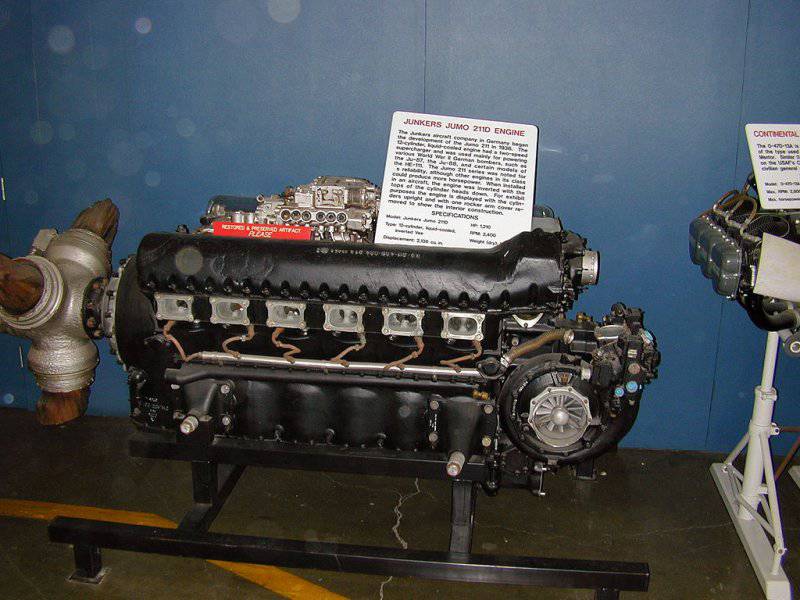
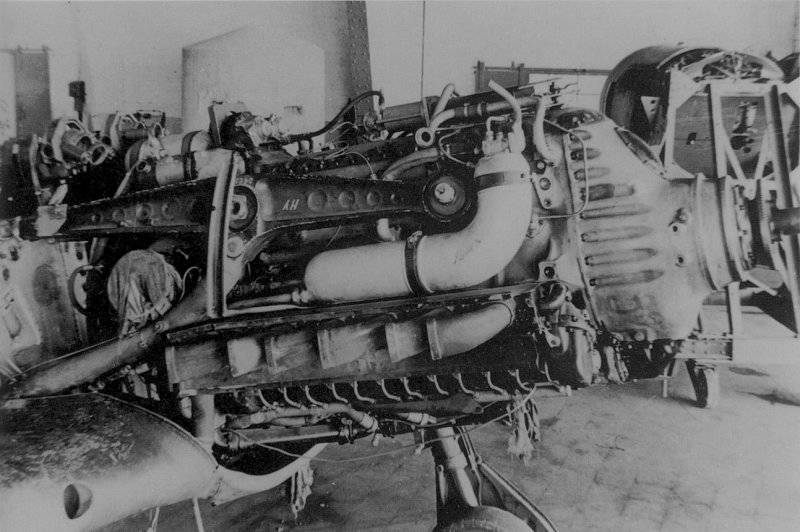
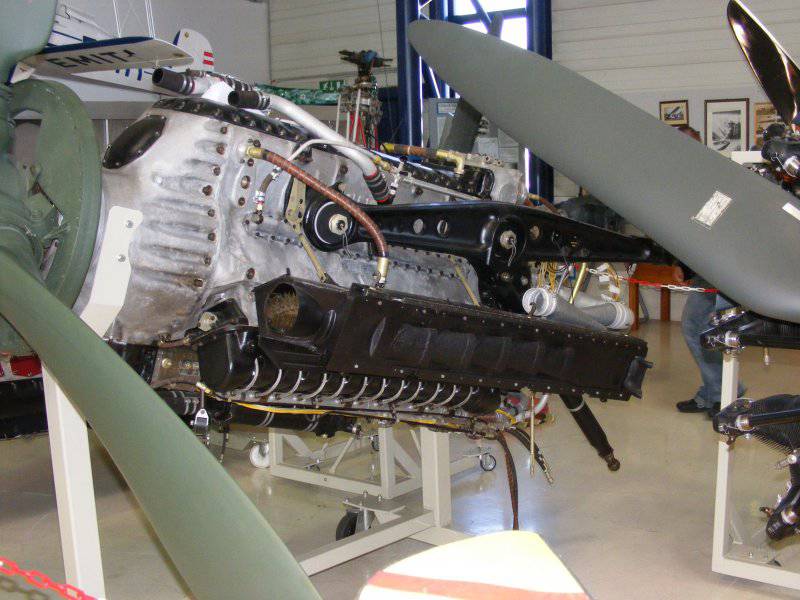
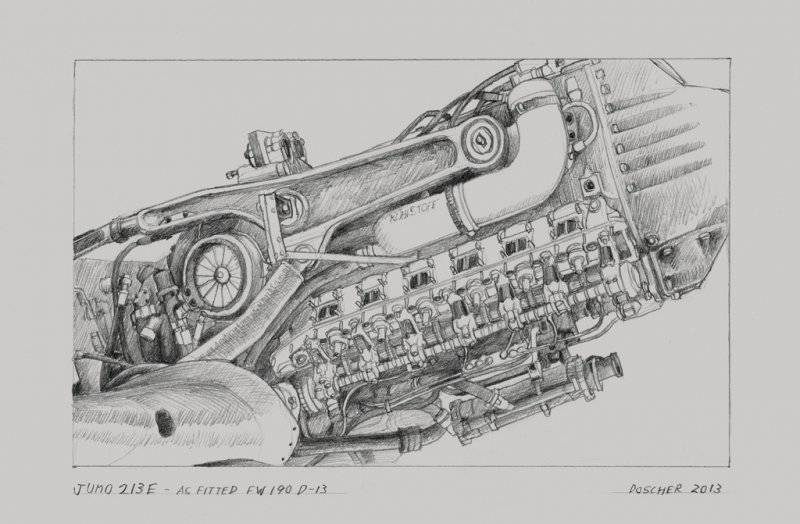
Information